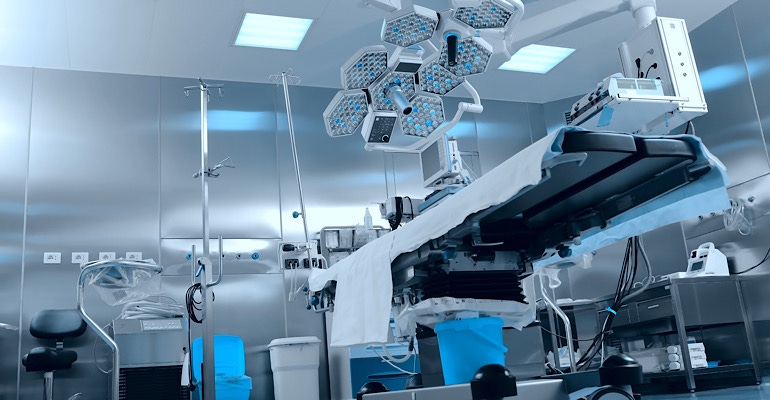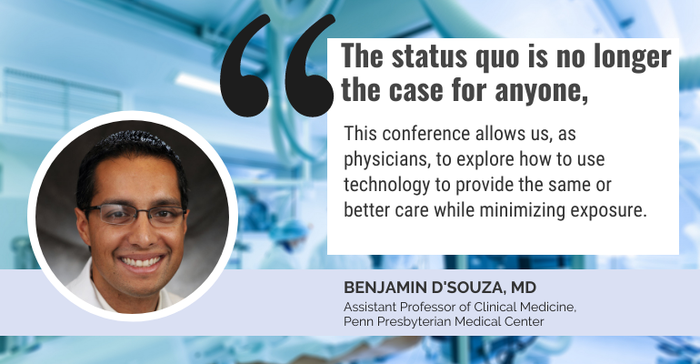Telemedicine has emerged as a safe, effective alternative to in-person doctor-patient visits. Can telerobotic surgery follow suit?
July 6, 2020

As we continue to fight SARS-CoV-2, physicians have adopted virtual visits as way to provide care while keeping both doctor and patient safe. Telerobotic surgical systems offer similar benefits: the lead surgeon works from an isolated station away from the patient, and patients who live in rural areas can receive specialist care without traveling long distances.
With the arrival of 5G, as well as other advances in robotics and telemedicine, telerobotic surgery is in a good position to become part of clinical care. However, network issues, privacy issues, medical licensing, regulatory issues, reimbursement and clinical and patient acceptance all present barriers to more widespread adoption.
To address those issues, as well as to demonstrate what’s possible for the future, Stereotaxis formed the Telerobotic Surgery Leadership Council, a consortium of physicians who use the technology as well as robotics companies that develop it. The leadership council held its first event in June: an afternoon virtual symposium featuring a live cross-continental telerobotic surgery—also a first—and a series of panel discussions.
“We want to leverage the fact that we have a more connected world, and that geographically-remote physicians and company representatives can offer valuable insights that improve procedure outcomes,” said Stereotaxis Chairman and CEO David Fischel. “It would be a shame to not allow that connection to take place. We organized the symposium to more clearly define best use cases, how the healthcare system can benefit and where the challenges are. This was meant to be the start of a conversation.”
“The status quo is no longer the case for anyone,” said Benjamin D’Souza, MD, a cardiologist and cardiac electrophysiologist at Penn Presbyterian Medical Center in Philadelphia, Pennsylvania. “This conference allows us, as physicians, to explore how to use technology to provide the same or better care while minimizing exposure.”
Backseat Driver
The event kicked off with a cardiac ablation procedure performed by two physicians more than 1,000 miles apart. Pedro Adragao, MD, PhD, a cardiologist at Hospital Da Luz, in Lisbon, Portugal, and Carlo Pappone, MD, of Policlinico San Donato, in Milan, Italy, collaborated on the procedure.
The first patient, a 62-year-old man with atrial fibrillation, was operated on by Pappone in Milan with navigational assistance from Adragao from his office in Lisbon. The second patient, a 43-year-old man with significant premature ventricular contractions, was operated on by Adragao with the assistance of Pappone. “The goal is to show the potential of the technology to perform remote mapping and ablation,” Pappone said at the start of the demonstration.
Following the procedures, Pappone reported no perceivable delay in network connection. They used each hospital’s local network, accessed remotely using VPN connections and Stereotaxis’ Odyssey Cinema Studio connectivity technology.
Both doctors regularly perform ablations robotically. Pappone said he has even performed ablations from his house when it wasn’t possible to be in the hospital. In those cases, a senior electrophysiologist would position the catheter and remain at the patient’s bedside.
Pappone assured viewers telerobotic surgery is safe for both patients and physicians. The physicians’ skills and knowledge are what’s important, not their physical presence, he said.
A Path Forward for Telerobotic Surgery
Cross-country or transcontinental telerobotic surgical procedures are uncommon. The first successful telesurgery, called “Operation Lindbergh,” took place in 2001. A doctor in New York City performed a laparoscopic gall bladder intervention on a patient in Strasbourg, France. Since then, issues with video communication, lag time, jitter, and bandwidth have made long-distance telesurgery problematic.
That’s starting to change, however, as video and network systems have improved. In September 2019, Corindus published a report in The Lancet on the “world’s first percutaneous coronary intervention procedures conducted from a remote location outside the catheterization lab using Corindus’ CorPath technology platform.”
Telerobotic surgery has its advantages, including:
Reduced radiation exposure for physicians.
Allows for technical support, continued education and training from medical device manufacturers without virus transmission risk.
Allows physicians from disparate areas to support each other in complex cases.
Allows for the proctor-student relationship to continue remotely.
Allows physicians to observe procedures without risking travel and an in-person visit.
The typical way for physicians to learn new techniques—in-person observation and training—has been hampered by COVID-19. Medical device representatives also can’t access hospitals to provide in-person support. In both cases, remote support is key.
In a best-case scenario, an electrophysiologist specialized in a particular technique could remotely oversee a complex procedure, offer advice and provide practical support when beneficial or needed. Or, a physician interested in learning new skills could observe live procedures performed by the expert. “Procedure proctoring is a core part of medical training,” Fischel said. “In-person observation may not disappear entirely, but we can imagine a much more efficient and effective way going forward.”
In theory, telerobotics could also allow more patients to have access to specialists. A patient in rural Texas, for example, that needs immediate surgery could get the care she needs even if there wasn’t a local surgeon available. A surgeon in the opposite end of the state could log on and perform the procedure. The technology is available to create this reality; however, many logistical, financial and regulatory hurdles must be overcome.

The Telerobotic Leadership Council welcomes dialog from other robotic surgery companies and physicians both within and outside of cardiology.
“This is a broad collaborative effort,” D’Souza said. “We hope to find ways to push medicine forward.”
“The concept of siloed operating rooms may be today’s reality, but it is not optimal for patient care or the healthcare system,” Fischel said. “Increased collaboration and connectivity in the operating room should benefit patients, physicians, hospitals and healthcare systems. It’s to society’s detriment not to consider it.”
References
Avgousti S, Christoforou EG, Panayides AS, et al. Medical telerobotic systems: current status and future trends. Biomed Eng Online. 2016;15(1):96. Published 2016 Aug 12. doi:10.1186/s12938-016-0217-7
Heather R. Johnson is a medical device, healthcare, and life sciences writer based in Oakland, CA.
About the Author(s)
You May Also Like




